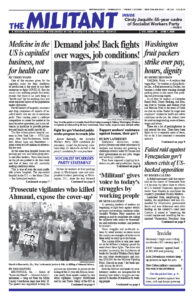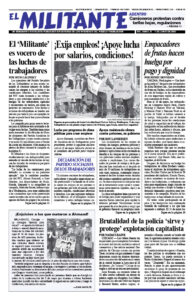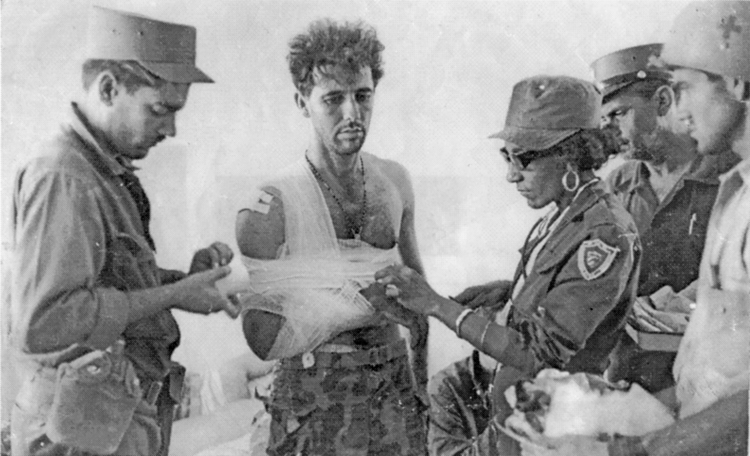One of the excuses given by the capitalist rulers for their shutdown of production is the need to use their resources to fight COVID-19. But the social crisis working people face today reveals that there is no such thing as “health care” for the working class and other exploited layers of the population under capitalism.
For the owners of hospitals, insurance and drug companies all aspects of so-called health care are run to maximize profit. Their starting point is cutthroat competition to corner the market in the most lucrative operations, not to use advances in medicine to provide preventive and hands-on health care for all.
The five richest private hospital systems in New York City — NYU-Langone, New York-Presbyterian, Northwell, Mount Sinai and Montefiore — spent a total of $149 million on advertising last year.
At the same time hospital bosses are pushing pay cuts and furloughing nurses and other workers. Those who remain on the job are pushed to do their work and that of those laid off, inevitably making conditions worse.
This is true of even the most profitable private hospitals. The top-ranked hospital in the U.S. — the Mayo Clinic — has furloughed workers.
Public hospitals that depend for funding from government programs are in the worst shape. New York Gov. Andrew Cuomo ordered University of Brooklyn hospital in New York City to take only coronavirus patients in March. Nurses at the facility — which has a leaking roof and uses plastic tarps held together with duct tape to separate patients — had their workload doubled.
Inside the hospitals like the Mayo Clinic there are glaring expressions of class differentiation. “The Minnesota-based hospital system promotes its services to well-off patients,” the New York Times reported May 15, with “luxury amenities such as hotel-like suites with fluffy bathrobes, private dining rooms and access to chef-cooked meals.”
Care for elderly workers in nursing homes is the opposite. They are built to keep residents in tight proximity, to cram in as many as possible, with insufficient staff to provide care maximizing profits for the owners. Well before the current pandemic, an estimated 380,000 residents of nursing homes nationwide died from infectious diseases every year.
Under these conditions Cuomo ordered nursing home bosses to admit patients diagnosed with COVID-19, with no time or space to establish quarantine. The measure fueled the spread of the disease and ensured the deaths of thousands.
Hospitals close during pandemic
The pace of hospital closures in rural areas — and in working-class neighborhoods in many larger cities — has reached record highs in recent years. Bosses say too many people pay with Medicare or Medicaid, and they can’t get the big bucks they need to make profits. The Mayo Clinic rakes in $566 for each obstetric ultrasound for patients with private insurance — five times more than Medicaid pays for the same procedure.
Today’s crisis means more will go broke, as state governments order a halt to all “nonessential” procedures like colonoscopies, mammograms, even some cancer screening and treatment that reap in higher profits.
Some 30 million workers don’t earn enough to afford a health insurance policy. And insurance often has nothing to do with health care. An estimated 50 million more can only afford cheaper plans with daunting co-pays and deductibles, and simply can’t afford many procedures or treatment they sorely need.
The callous values of those who dictate what working people get was demonstrated last month by New York state officials who issued a “do-not-resuscitate” order for any patient paramedics picked up without a discernable pulse. The death sentence was ordered to “conserve resources,” they said. It was withdrawn after a public outcry.
Workers fight for health care
In the course of struggles against the bosses and their governments over wages and working conditions, workers will fight for access to health care as a basic human right.
One of the best examples was how coal miners and their families fought tenaciously to force the coal bosses and the government to take steps to push back the debilitating black lung disease in the late 1960s. They forced state governments to establish clinics across the coalfields and provide disability benefits. Union safety committees were empowered to shut down production whenever they judged conditions were unsafe. In the process miners took back control of their union.
Since then these gains have been eroded by the bosses, and today the federal government is looking to get out of responsibility for assuring black lung benefits to retired miners. There will be no fundamental advance in “health care” as long as the capitalist class retains power.
The central leaders of the two great revolutions of the 20th century — Vladimir Lenin in Russia and Fidel Castro in Cuba — led working people to take power and transform social relations, including the organization of medical care.
Speaking at the Second All-Russia Congress of Medical Workers in 1920, after the Bolshevik-led 1917 revolution, Lenin noted that there was a time when “members of the medical profession entertained a distrust of the working class.”
“But now they, too, are convinced that only together with the proletariat will it be possible to achieve a flourishing state of culture in Russia. Only collaboration between scientists and workers can put an end to oppressive poverty, disease and dirt. And this will be done.” For the first time in history working people and their state reorganized health care for all as a basic human right.
Cuba’s revolutionary leadership did not wait until the victory in 1959 to begin taking control over health care. They established field hospitals in the territories they conquered to treat all who needed care during the revolutionary war, including wounded enemy soldiers.
The 1959 victory and overturn of capitalist rule opened the door for working people to begin to run society themselves in the interests of all.
One result is that doctors live in the working-class neighborhoods they practice in, and organize to visit people regularly. This isn’t because they have a “better health care system,” but because of different social relations that could only arise from making a socialist revolution.
Working people are capable of doing the same thing everywhere.


